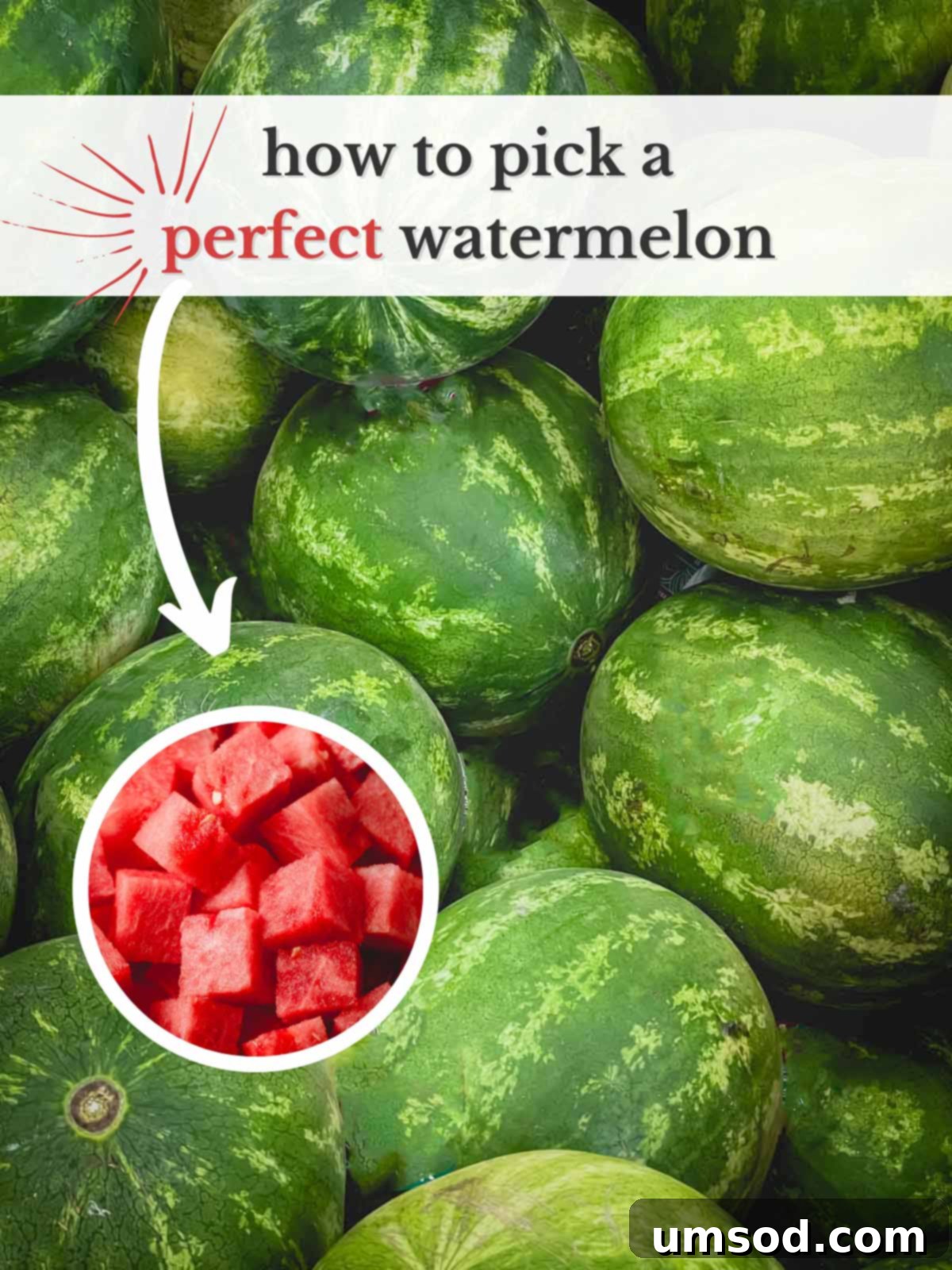The Ultimate Guide to Picking a Perfect Watermelon: Sweet, Ripe, and Juicy Every Time
Nothing embodies the essence of summer quite like the refreshing taste of a perfectly ripe watermelon. Its vibrant red flesh, crisp texture, and juicy sweetness make it an undeniable staple at backyard barbecues, beach picnics, and family gatherings. But the joy of biting into that ideal slice often begins with a crucial step: knowing how to pick the right one. This comprehensive guide will transform you into a watermelon connoisseur, revealing the secrets to selecting a melon that’s sweet, juicy, and ready to be savored.
From understanding the tell-tale signs of ripeness to exploring the diverse world of watermelon varieties, we’ll equip you with all the knowledge needed to make every watermelon purchase a triumph. Get ready to master the art of choosing this iconic summer fruit and impress your friends and family with your newfound expertise!
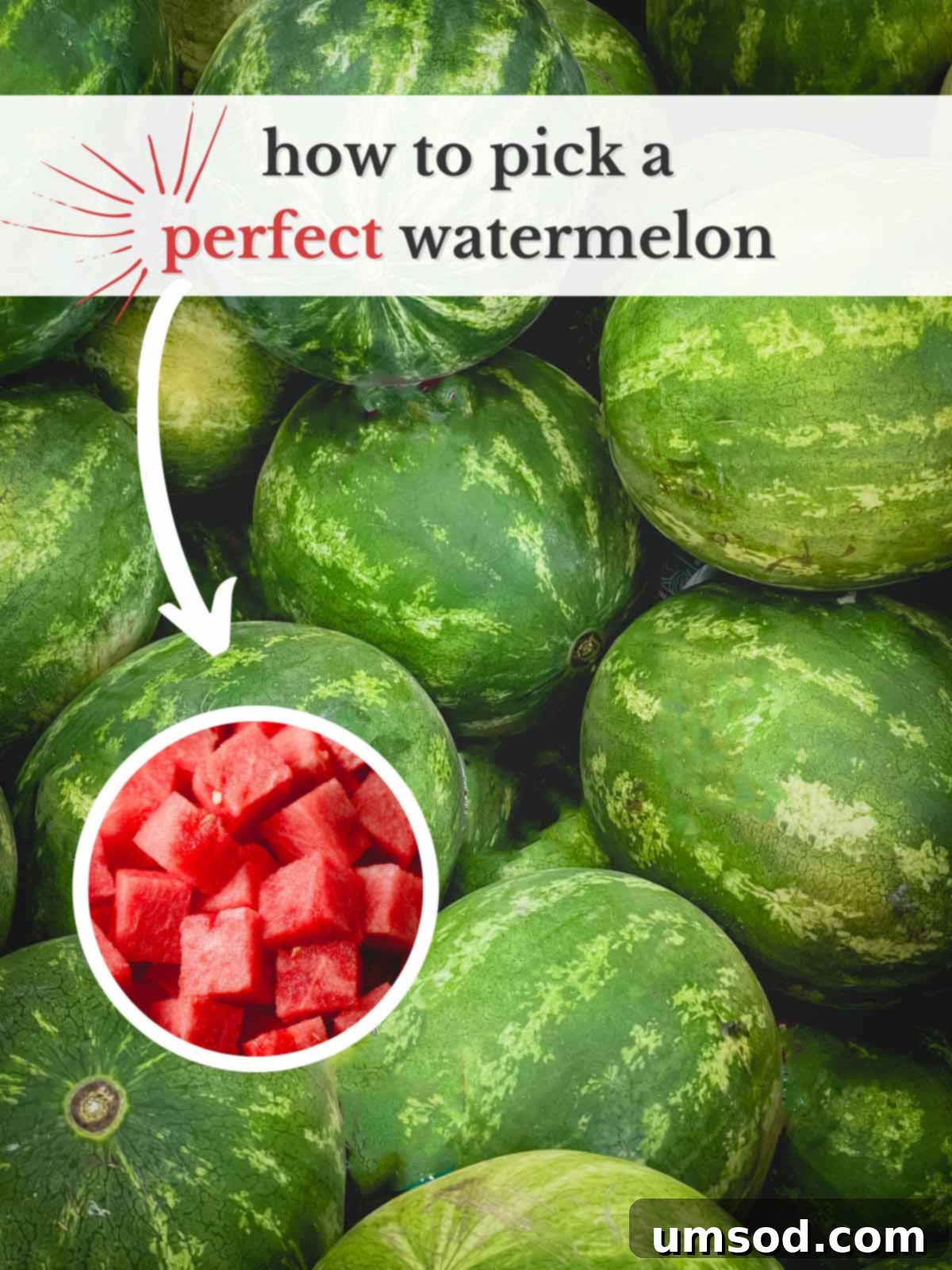
When is Watermelon Season? The Best Time to Buy
While watermelons are increasingly available year-round in many supermarkets, their peak season offers the best flavor and ripeness. For the sweetest, most flavorful melons, aim to purchase them between May and September. This is when watermelons are in their prime, having been allowed to ripen fully under the summer sun, ensuring that iconic sweetness we all crave.
Knowing the season is just the first step. The true challenge lies in distinguishing a perfectly ripe melon from one that’s under or overripe. Fortunately, there are several simple yet effective techniques you can use. Below, we delve into the five essential signs that will help you select a sweet, juicy watermelon every single time.
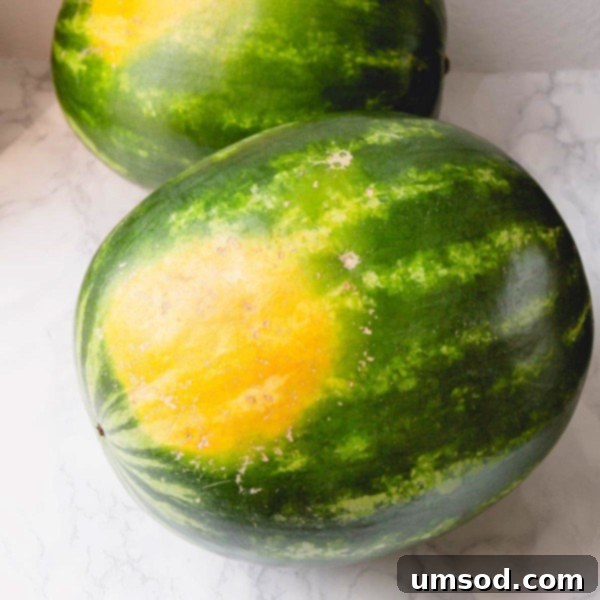
How to Pick a Sweet Watermelon: 5 Essential Signs of Ripeness
Selecting a truly delicious watermelon is more than just luck; it’s about observing key indicators of ripeness. By paying attention to these five crucial signs, you can consistently choose a melon that’s bursting with natural sugars and refreshing juice. Let’s explore each one in detail.
1. The Field Spot: A Golden Indicator of Sweetness
- Look for a deep yellow, creamy patch: This distinctive mark, often called the “field spot” or “ground spot,” is where the watermelon rested on the ground as it ripened in the sun. A truly sweet and ripe watermelon will have a prominent, deep yellow, or even orange-yellow spot. This indicates that the melon spent ample time on the vine maturing naturally, absorbing all the necessary nutrients and sugars.
- Avoid pale or white spots: If the field spot is pale white or light green, it’s a strong sign that the watermelon was picked prematurely. Such melons often lack the desired sweetness and intense flavor, as they didn’t have enough time to fully develop on the vine. The deeper and more vibrant the yellow, the sweeter the melon is likely to be.
2. The Dullness Factor: A Sign of Maturity
- Opt for a dark, dull rind: A ripe watermelon typically has a dark, muted green color and a dull, matte finish. This dullness suggests that the melon has fully matured and is ready for consumption.
- Steer clear of shiny skin: Conversely, a watermelon with a shiny, bright green rind usually indicates that it’s not yet ripe. The shiny appearance suggests it’s still in its growth phase and hasn’t had enough time to develop its full flavor profile and sweetness.
3. Weight for Its Size: The Juicier, The Heavier
- Pick it up: A heavy watermelon for its size is almost always a sweet watermelon. Watermelons are over 90% water, so a heavier melon signals a high water content, which directly translates to juiciness and flavor.
- Compare a few: Don’t hesitate to compare a few watermelons of similar size. Pick them up and feel their heft. The one that feels significantly heavier than others of the same dimensions is likely to be the juiciest and most flavorful choice.
4. The Knock Test: Listen for Sweetness
- Tap and listen for a hollow sound: Give the watermelon a firm tap with your knuckles. A ripe, juicy watermelon will produce a deep, hollow sound, almost like tapping on a drum. This resonance indicates that the flesh inside is crisp, firm, and full of water.
- What to avoid: If you hear a dull, flat thud, it might mean the flesh is soft or overripe. A very shallow or high-pitched sound could indicate it’s underripe and too dense. Practice this on a few melons to get a feel for the difference – you’ll quickly learn to distinguish the satisfying hollow sound of ripeness.
5. Rind Firmness: No Soft Spots Allowed
- Check for a firm rind: Gently press on the watermelon’s rind all around. A ripe watermelon will have a firm, robust exterior without any soft or squishy spots.
- Avoid soft or mushy areas: Any soft or mushy areas indicate that the watermelon is likely bruised, overripe, or beginning to spoil. These spots are a clear sign to put that melon back and choose another. The rind should feel uniformly firm and taut.
Bonus Tip: The Appearance of “Webbing” or “Sugar Spots”
- Look for brown, web-like marks: Sometimes, you’ll notice brown, rough patches that look like spider webs on the watermelon’s surface. These “webbing” marks are formed when bees pollinate the flower, and the fruit is scratched during its early development. More webbing typically suggests more bee activity and often correlates with a sweeter melon.
- Small black dots (sugar spots): Tiny black spots or streaks can also indicate areas where sugar is seeping out, another good sign of ripeness and sweetness.
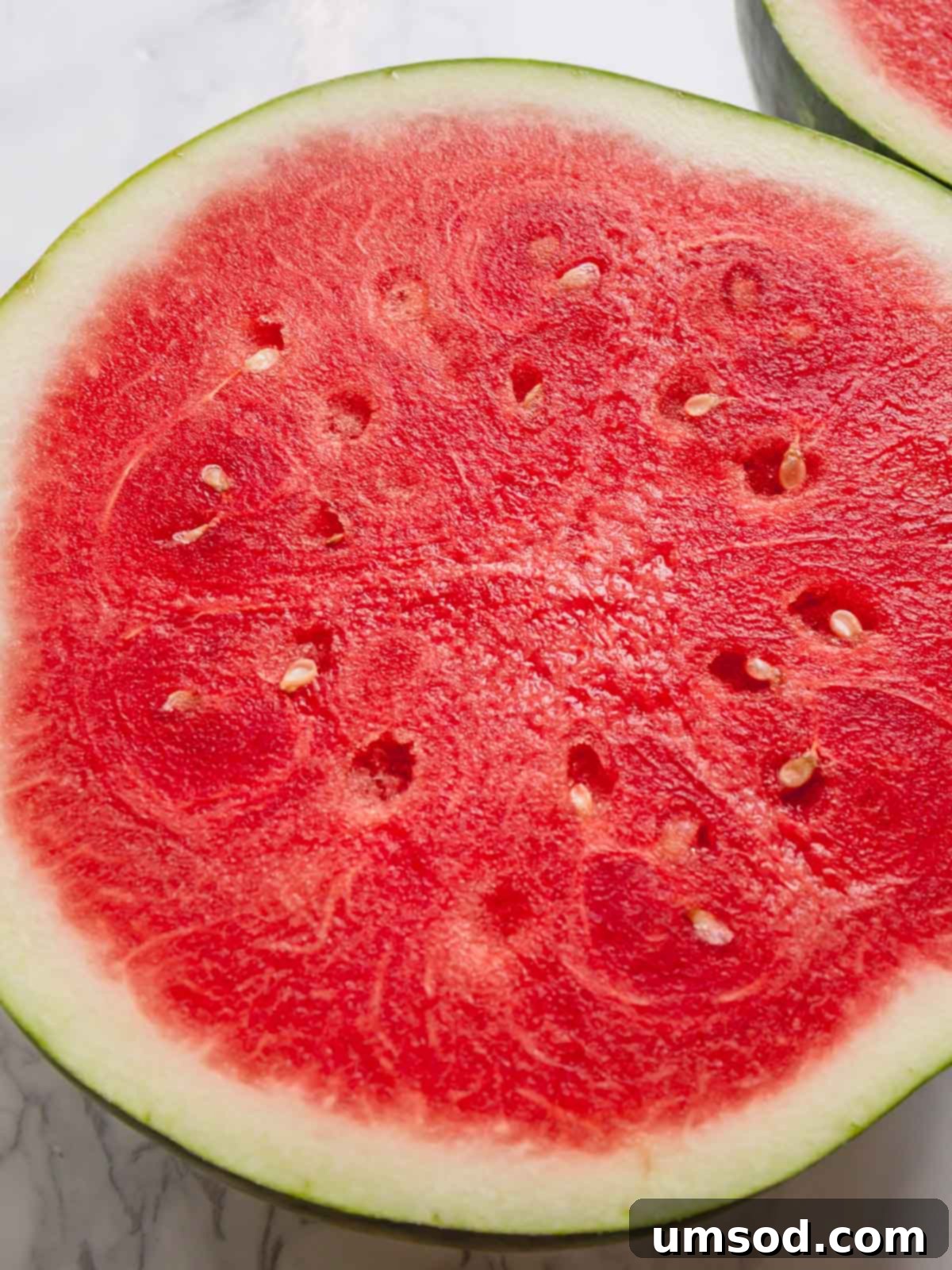
Watermelon Varieties: A World of Flavors and Sizes
Beyond the classic red, seeded melon, the world of watermelons is surprisingly diverse, offering a range of sizes, shapes, colors, and flavors. With over 300 watermelon varieties grown globally, including many throughout the United States and South America, there’s a perfect melon for every preference and occasion. They can generally be categorized into four main groups, each with its unique characteristics:
- Seedless Watermelons: A modern marvel, these hybrids are perfect for those who prefer to enjoy their watermelon without the hassle of spitting out seeds. While they do contain tiny, edible white seed coats that haven’t matured, they lack the hard, black seeds. They typically have a crisp texture and a consistently sweet flavor, making them incredibly popular for snacking and salads.
- Picnic Watermelons: As their name suggests, these are the large, traditional watermelons ideal for feeding a crowd at picnics or large gatherings. They are generally oblong or round, weighing between 15 to 45 pounds. Most people picture a picnic watermelon when they hear the word “watermelon,” characterized by a bright green rind, deep red flesh, and prominent black seeds. Classic examples include the ‘Crimson Sweet’ and ‘Charleston Gray’.
- Yellow-Orange Fleshed Watermelons: Offering a delightful twist on the classic, these varieties feature flesh that ranges from a sunny yellow to a vibrant orange. Their flavor profile is often described as sweeter and more honey-like than red watermelons, sometimes with hints of apricot. Popular varieties include ‘Yellow Doll’ and ‘Orangeglo’, providing a visually stunning and uniquely flavored option for your summer fruit platters.
- Icebox Watermelons: Perfect for smaller families or those with limited refrigerator space, icebox watermelons are compact and typically weigh between 5 to 15 pounds. Their smaller size makes them easy to chill in an “icebox” (or a modern refrigerator). Despite their modest size, they pack a powerful punch of sweetness and juicy flavor. Two common and well-loved varieties are the ‘Sugar Baby’, known for its dark green rind and deep red flesh, and ‘Tiger Baby’, with its distinctive striped rind.
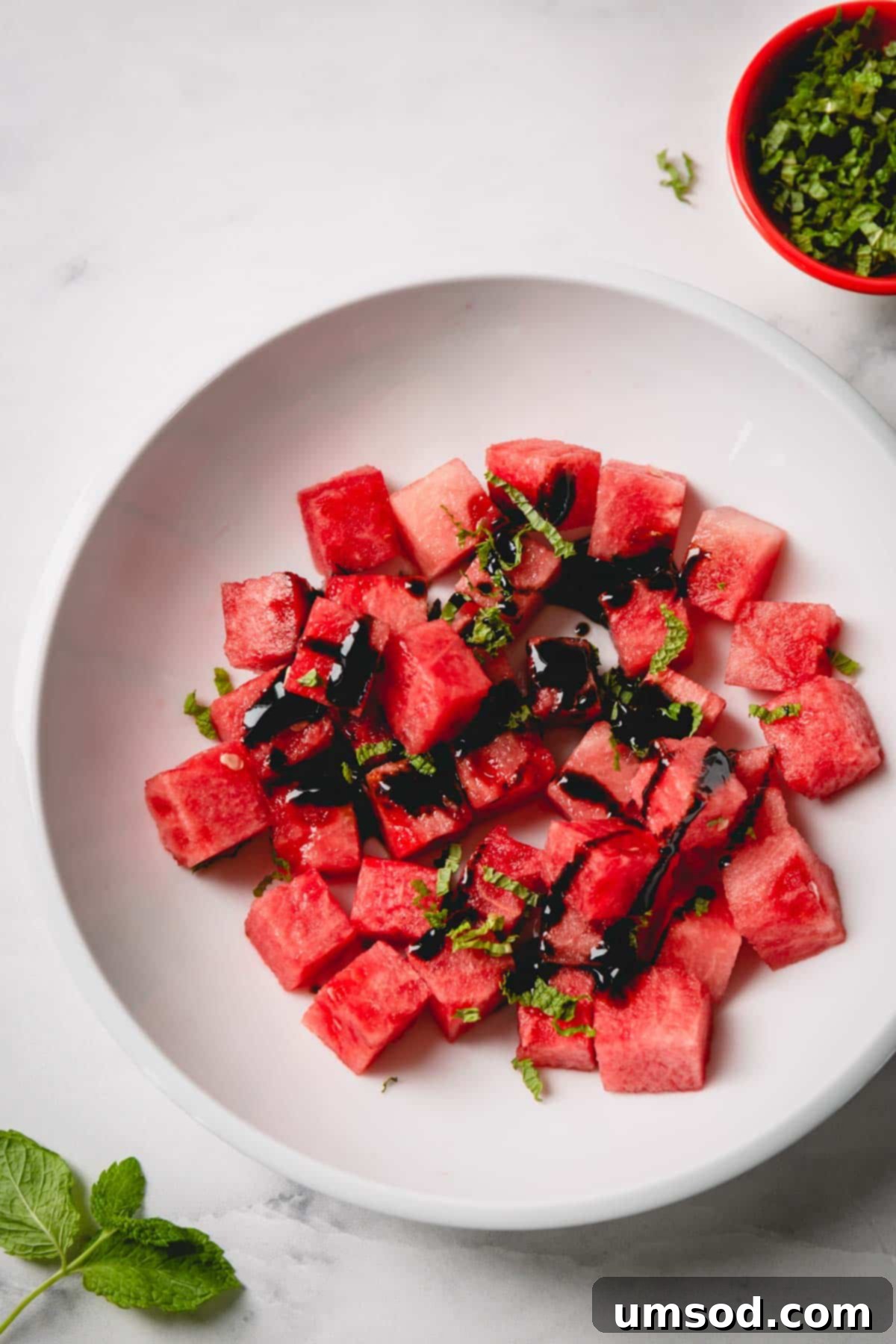
Creative Ways to Enjoy Watermelon All Summer Long
Now that you’ve mastered the art of picking a perfect watermelon, it’s time to unleash your culinary creativity and enjoy this refreshing fruit in countless delicious ways! Watermelon is incredibly versatile, lending itself to everything from sweet drinks and refreshing salads to unique savory dishes. Here are plenty of ideas to inspire you:
- Refreshing Beverages:
- Blend it into a sweet and boozy frozen daiquiri for an adult treat, or a virgin slushie for all ages.
- Make a vibrant minty watermelon soda or simply infuse water with chunks of watermelon and mint for a hydrating twist.
- Create your favorite summer mashup – homemade watermelon lemonade for a tangy-sweet delight.
- Pour pureed watermelon into popsicle molds for a healthy, refreshing treat on a scorching hot day.
- Sweet & Savory Salads:
- Toss cubed watermelon with crisp salad greens, salty feta cheese, and a drizzle of balsamic glaze for a nutrient-packed, balanced salad.
- Try this specific and highly acclaimed watermelon feta salad recipe for a perfect blend of sweet and savory.
- Combine with cucumber, red onion, and fresh herbs like basil or cilantro for a light and vibrant side dish.
- Unique Culinary Adventures:
- Drizzle watermelon cubes with a high-quality balsamic vinegar and sprinkle with chopped fresh mint for an unexpectedly sophisticated appetizer or dessert.
- For a kick of “sweet heat,” sprinkle watermelon wedges with chili powder (like Tajín) and a squeeze of lime juice – a popular combination in many cultures.
- Grill thick slices of watermelon for a smoky, caramelized flavor that pairs wonderfully with grilled meats or as a standalone side.
- Incorporate it into a chilled gazpacho for a unique, refreshing twist on the classic soup.
- Desserts & Snacks:
- Cut into fun shapes for a vibrant fruit platter.
- Serve cold, straight from the fridge as a simple, hydrating snack.
With so many options, you’ll never run out of ways to enjoy the incredible taste and hydrating benefits of watermelon throughout the entire summer season!
Nutritional Information & Health Benefits of Watermelon
Beyond its delicious taste, watermelon is a nutritional powerhouse, especially known for its high water content and beneficial nutrients. It’s an excellent choice for staying hydrated and supporting overall health during warm weather. Here’s a closer look at what makes watermelon so good for you:
- Excellent Hydration: Watermelons are famously 92% water, making them an incredibly easy and satisfying way to stay hydrated. This high water content also contributes to feelings of fullness, which can be beneficial for weight management.
- Low in Calories: Despite its sweet flavor, watermelon is relatively low in calories, offering a guilt-free way to satisfy your sweet cravings.
- Rich in Vitamins and Minerals: Watermelon provides a good source of several essential vitamins and minerals.
- Antioxidant Powerhouse: Watermelon is packed with antioxidants, most notably lycopene. Lycopene is a powerful carotenoid responsible for the fruit’s red color and is linked to various health benefits, including heart health, bone health, and protection against certain types of cancer. It also contains cucurbitacin E, which has anti-inflammatory properties.
Nutritional Breakdown (Per 1 cup of diced watermelon, approximately 152 grams):
- Calories – 46
- Fat – 0.2 grams
- Sodium – 1.5 mg
- Carbs – 11.5 grams
- Fiber – 0.6 grams
- Sugar – 9.4 grams
- Protein – 0.9 grams
- Vitamin C – 12.3 mg (14% of daily value)
- Vitamin A – 42.6 mcg (5% of daily value)
- Potassium – 170 mg (4% of daily value)
Incorporating watermelon into your diet is a delicious and healthful choice, offering both refreshment and vital nutrients to keep you feeling great all summer long.
Watermelon FAQs: Your Questions Answered
Still have questions about this beloved summer fruit? Here are some frequently asked questions to ensure you’re a true watermelon expert.
A ripe watermelon should always be firm to the touch. Check the rind thoroughly for any soft, mushy, or discolored spots, which are clear indicators of an overripe or spoiling watermelon. If you cut it open, the flesh should be uniformly bright red (or yellow/orange, depending on variety), crisp, and juicy. If the flesh appears noticeably dark, stringy, mushy, slimy, or has an off-odor, it has most likely gone bad and should be discarded. Trust your senses!
Yes, watermelon seeds are entirely edible and safe to eat! If you consume them raw, your digestive system will generally not break them down, and they will simply pass through your system largely intact. While raw seeds do contain some nutrients, you only fully reap their benefits – like protein, magnesium, and healthy fats – if they are sprouted, roasted, or ground. Roasted watermelon seeds make a surprisingly delicious and nutritious snack!
One of the most reliable indicators of a sweet watermelon is its “field spot” or “ground spot.” This is the patch where the melon rested on the ground during ripening. The bigger and more vibrant yellow (or even orange-yellow) this spot is, the sweeter the melon will likely be, as it signifies ample time spent maturing on the vine. Combine this with a dull rind, a heavy feel for its size, and a hollow sound when tapped, and you’re almost guaranteed a sweet choice!
An uncut, whole watermelon can last for about 10-14 days at room temperature (around 60-70°F or 15-21°C). If stored in a cooler place, like a pantry or basement, it can last up to 2-3 weeks. Once refrigerated, a whole watermelon can extend its freshness to 3 weeks or even slightly longer.
Absolutely! Watermelon freezes well, though its texture will change once thawed, becoming softer and less crisp. It’s best for use in smoothies, frozen drinks, sorbets, or even purées for cocktails rather than eating plain. To freeze, cut the watermelon into cubes, slices, or balls, remove the seeds if desired, and arrange them in a single layer on a baking sheet to freeze solid before transferring to a freezer-safe bag or container.
The white part of the watermelon, located between the red flesh and the green rind, is called the rind. Not only is it edible, but it’s also packed with nutrients, including citrulline, an amino acid beneficial for heart health and circulation. While its texture is firmer and less sweet than the red flesh, it can be pickled, stir-fried, juiced, or even used in chutneys and jams. Don’t throw it away!
Embrace the Sweetness of Summer with Every Watermelon
With the knowledge gained from this guide, you are now equipped to confidently choose the best watermelon every time. Remember to check for that golden field spot, the dull rind, the surprising weight, the hollow sound, and the firm exterior. Each sign is a clue leading you to a perfectly ripe, sweet, and juicy melon.
Whether you prefer a classic seeded variety, the convenience of seedless, the unique charm of yellow-fleshed, or the compact size of an icebox melon, there’s a watermelon out there waiting to brighten your summer. So go ahead, head to your local market, and put your newfound skills to the test. Dive into a slice, feel the refreshing juice drip down, and truly savor the iconic taste of summer. Happy melon picking!
